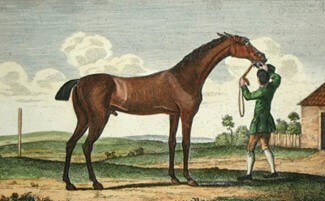
Consider that the Y Chromosome descendant stallions of the Godolphin Arabian and Byerley Turk Stallions will soon be extinct, leaving just the male line descendants of the Darley Arabian present as sires of future Thoroughbred horses. What is the likely genetic consequences of having just one active Y Chromosome male line being reproduced in the Thoroughbred breed?
Genetic Consequences of Single Y Chromosome Line in Thoroughbreds by John Ryan (Melbourne- Autralia)
Genetic Consequences of Single Y-Chromosome Sire Line in Thoroughbred Horses
Background: Foundation Sire Lines and Paternal Legacy
Thoroughbred racehorses trace their pedigree in direct male line (tail-male) to one of three foundation stallions imported to England in the late 17th and early 18th centuries 1. These founders - the Darley Arabian, Godolphin Arabian, and Byerley Turk - established the original sire lines of the breed. Over time, however, the dominance of the Darley Arabian's lineage (through his famed great-great-grandson Eclipse) has vastly overshadowed the others. It's estimated that at least 95% of living Thoroughbreds today carry the Darley Arabian/Eclipse Y-chromosome in tail-male descent 2. By contrast, the direct male-line descendants of the Godolphin Arabian (sire line of Matchem and Man o' War) and the Byerley Turk (sire line of Herod and others) have dwindled to the brink of extinction in the modern Thoroughbred population 3. In other words, the breed's paternal lineage has effectively been reduced to a single active Y-chromosomal line, with only a handful of outlier stallions carrying the other Y haplotypes.
To illustrate the current status of these sire lines:
|
To illustrate the current status of these sire lines: Foundation Stallion (Line) |
Y-Chromosome Haplotypes in TB |
Modern Status |
|
Darley Arabian (1700) |
3 subtypes identified |
Dominant (~95%) |
|
Godolphin Arabian (1724) |
2 subtypes identified |
Nearly extinct |
|
Byerley Turk (1680) |
5 subtypes identified |
Virtually extinct |
Table: The three foundation sire lines of the Thoroughbred, their Y-chromosome haplotypes and current status in the breed. Modern genetic analyses of the Y chromosome confirm the severe contraction of paternal diversity: among Thoroughbreds, about ten distinct Y haplotypes (sub-lineages) have been identified in total - 3 from Darley Arabian, 2 from Godolphin Arabian, and 5 from Byerley Turk - but well over 90% of living stallions belong to Darley's line 1.
Notably, recent DNA evidence even corrected historical pedigree records (e.g. reassigning the famed 19th-century sire St. Simon to the Byerley Turk haplotype), yet this does not change the reality that Darley's lineage is now overwhelmingly prevalent 1. The Byerley Turk sire line largely died out by the late 20th century its last prominent representatives, such as Precisionist and Arcangues, failed to extend the line) 4. The Godolphin/Matchem line has only a "small handful" of regional stallions left after the recent pensioning of Tiznow (the last high-profile U.S. sire of that line) 4. In short, the Darley Arabian's Y-chromosome now reigns almost alone in the Thoroughbred gene pool, raising concerns about the genetic consequences of this monoculture in a breed famed for its athleticism.
Loss of Y-Chromosome Diversity and Genetic Bottlenecks
The near-loss of two out of three sire lines signifies an extreme bottleneck in the Y-chromosomal gene pool. The Y chromosome is passed exclusively from sire to son and serves as a marker of paternal lineage. Having only one predominant Y lineage means that male Thoroughbreds are almost all carrying an identical or very closely related set of Y-chromosome genes. Studies show that modern horse populations in general demonstrate extremely low Y-chromosome diversity compared to their mitochondrial DNA diversity, due to centuries of selective breeding using very few stallions 5. The Thoroughbred is an archetypal example: a closed studbook for over 300 years with only three male founders has led to a paternal genetic monoculture 1, 2.
This loss of Y diversity is not merely a genealogical curiosity,but has tangible genetic implications. The effective population size of the breed is greatly reduced when so many individuals share the same paternal ancestors. In population genetics terms, the "founder effect" is strong in Thoroughbreds - the breed was founded by very few individuals, so much of the genome (especially the Y) traces back to those founders. Modern genomics research confirms a significant ongoing decline in genetic variation in Thoroughbreds over recent decades, correlating with the heavy concentration of a few sire lines 6. In a 2020 study of over 10,000 Thoroughbreds worldwide, researchers documented a highly significant erosion of genetic diversity in the last 50 years, likely driven by the repeated use of popular stallions and their male descendants 6. The practice of favoring a small number of fashionable sires (often from the dominant Darley/ Eclipse line) amplifies genetic drift and causes valuable alleles from less represented lines to be lost from the population 6. Essentially, by "putting all eggs in one basket" with a single male lineage, the breed's gene pool becomes narrower with each generation.
One immediate consequence is inbreeding. All Thoroughbreds are interrelated to some degree (the studbook has been closed since the 18th century), but the decline to one main sire line increases the co-ancestry among individuals. Breeding choices become constrained, and many matings now inevitably pair horses that share common male-line ancestors (often Northern Dancer or other prolific Darley-line stallions) in their pedigrees. For instance, as of recent studies, 97% of Thoroughbred pedigrees include the stallion Northern Dancer (1961) in the lineage 1 - an indicator of how ubiquitous certain male-line ancestors have become. Likewise, in Europe and Oceania a majority of foals have Sadler's Wells or Danehill (both Northern Dancer-line sons) in their near ancestry 1. This concentration of ancestry drives up inbreeding coefficients. Genomic analyses measuring runs of homozygosity (ROH) find a steady rise in inbreeding in newer Thoroughbred generations compared to those 40-50 years ago 7. One recent study found a slight but measurable increase in homozygosity in horses born 2000-2020 relative to those born in the 1960s-1980s 7, reflecting the reduced diversity. The effective population size (N.) of the Thoroughbred is now quite small for a breed with a global census in the hundreds of thousands, because so many individuals descend from the same few sires. In practical terms, this means genetic drift and random loss of alleles is accelerated - the breed as a whole has less genetic "reserve" to draw on, having essentially winnowed down to one dominant male lineage worldwide 9.
It's worth noting that the Y chromosome itself carries relatively few genes, mostly related to male fertility and development. Thus, the direct functional effect of having only one Y haplotype might be subtle - there may be little difference in racing ability due purely to Y-chromosomal genes. However, the Y-line bottleneck is a symptom and emblem of overall genetic narrowing. It indicates that only one paternal lineage's genetic traits are being perpetuated, while any unique qualities harbored by the lost lines are disappearing from the gene pool. The Thoroughbred breed was historically "built on the interactions between these three lines" 1 - each sire line contributed to a richer genetic tapestry (through both paternal and maternal contributions in subsequent generations). Losing two of these lines means losing that original balance and the potential genetic variation it provided. Moreover, relying on one lineage increases vulnerability: if there were any deleterious mutation or weakness associated with the Darley Arabian Y line, it would now be carried by virtually all male Thoroughbreds with no alternative lineage to mitigate it. While no major Y-linked disorders have been identified in Thoroughbreds to date, lack of Y diversity removes a layer of genetic insurance for the breed's future. As one genetics expert put it, having more than one male lineage to choose from allows breeders to "select for the rarer lineages... which helps maintain diversity within the breed" 1. In the current situation, that choice is almost gone.
Health Implications of a Narrow Gene Pool
The health of the Thoroughbred breed can be impacted by the severe reduction in genetic diversity that accompanies a single dominant sire line. Low diversity and inbreeding are known to increase the prevalence of deleterious genes and inherited disorders. When the gene pool shrinks, harmful recessive mutations - normally rare - have a higher chance of being homozygous in foals, leading to genetic defects or vulnerabilities. Breeding horses that are too closely related (a side effect of everyone sharing common ancestors) can result in congenital issues like club foot (contracted tendons), developmental orthopedic problems, or even reduced fertility 10. Dr. Gus Cothran, a leading equine geneticist, notes that inbreeding in horses "can cause genetic defects like club foot and loss of fertility" when it accumulates unchecked 10. These outcomes are classic signs of inbreeding depression, where the overall fitness of the population drops because of expression of harmful genes.
In Thoroughbreds, breeders and veterinarians have observed a range of heritable health issues that may be exacerbated by a limited gene pool. Examples include orthopedic disorders such as osteochondritis dissecans (OCD), airway and breathing problems ("wind" issues like laryngeal hemiplegia), muscle metabolic conditions (tying-up), and bleeding propensity (exercise-induced pulmonary hemorrhage). Many of these conditions have a genetic component, and troublingly, they do not prevent affected horses from breeding - often such horses are treated or managed and then enter the breeding population 1. This means deleterious alleles can silently spread. A closed breeding pool with high use of a few sire lines can inadvertently propagate these weaknesses. As one report noted, modern veterinary interventions (surgery for wind issues or OCD, medications for bleeding and ulcers) allow horses with serious inheritable conditions to continue racing and later breed, "increasing the risk of spreading harmful genes in the population" 1. In a broader, more diverse population, natural selection or breeders might more easily eliminate such genes, but in the Thoroughbred, they can persist under the radar.
The rising inbreeding trends have already shown subtle impacts on horse wellness and development. A study in North America found that higher inbreeding coefficients were correlated with a decrease in the number of races a horse starts in its career 1. Horses with more intense inbreeding tended to have shorter or less robust racing careers, suggesting reduced physical durability or greater injury risk 1. This aligns with the concept that inbreeding depression can reduce vitality and resilience. More explicitly, a 2022 genomic study demonstrated that a 10% increase in a Thoroughbred's genomic inbreeding (F_ROH) was associated with a 7% drop in the likelihood of that horse ever making it to a race 8. In other words, highly inbred horses were meaningfully less likely to be sound or vigorous enough to enter training and competition. The same research identified a specific inbred genetic haplotype linked to cartilage development in the gene EFNA5) that, when homozygous, cut a horse's probability of racing by about one-third 8. This suggests that inbreeding had unmasked a deleterious variant affecting musculoskeletal health - likely contributing to career-ending breakdowns or orthopedic injuries in those horses 8.
Loss of genetic diversity can also mean loss of disease resistance. A diverse gene pool often includes a wide array of immune system genes (such as those in the Major Histocompatibility Complex, MHC). If a population becomes too genetically uniform, it may become uniformly susceptible to certain pathogens or illnesses. While Thoroughbreds generally benefit from widespread veterinary care, a narrow genetic base could hypothetically reduce the breed's ability to cope with new diseases or environmental stresses. Every Thoroughbred today being so closely related implies a limited range of immune gene variants compared to a more diverse breed. Though this is a more abstract concern, it underscores why conservation of genetic diversity is viewed as crucial for long-term population health and adaptability 10.
It should be noted that some recent genetic surveys of Thoroughbred populations have so far not detected an immediate crisis in health metrics. A comprehensive 2023/24 study of North American Thoroughbreds found only a modest rise in inbreeding compared to mid-20th-century horses and reported "no genetic ties to health concerns or durability" issues in the data 7. The authors suggested that current levels of inbreeding "aren't inherently problematic" yet 7, possibly because breeders have managed matings to avoid the most dangerous pairings. This indicates that inbreeding depression is a gradual threat - it may not have caused a collapse in soundness to date, but the risk compounds over time. Most experts still urge caution: the absence of obvious genetic decline now does not guarantee safety in the future if diversity continues to erode. The same study emphasized the need to monitor and avoid harmful genetic combinations going forward, leveraging tools like whole-genome sequencing to catch risk variants before they spread 7. In essence, while Thoroughbred breeders have "done a good job" so far according to genetic data 7, the warning signs (rising homozygosity, pervasive use of one male line, etc.) are prompting proactive measures to safeguard the breed's health.
Performance Traits and Athletic Impacts
Genetic diversity is not only about avoiding diseases - it is also linked to the range and quality of performance traits in a breed. The Thoroughbred has been intensely selected for racing ability, which includes speed, stamina, agility, and competitiveness. Historically, the three foundation sire lines were thought to each contribute something to this genetic mix - breeders valued the Eclipse (Darley) line for its speed and precocity, the Herod (Byerley Turk) line perhaps for its strength and stamina, and the Matchem (Godolphin) line for its soundness and staying ability (as suggested by the successes of their early descendants) 3. Whether or not those attributions were strictly accurate, having multiple unrelated male lines gave breeders options to outcross and blend traits. A diverse pedigree could harness "hybrid vigor," where a foal might outperform its parents if they came from genetically distinct lines.
With the near-total dominance of a single sire line, true outcrosses within the Thoroughbred breed are disappearing. When virtually every stallion descends paternally from Darley Arabian, any mating between two Thoroughbreds is now more of a linebreeding than an outcross in the traditional sense. The loss of the Byerley Turk and Godolphin Arabian lines means the loss of some unique alleles and trait combinations those lines carried. One concrete example is the shifting balance between speed and endurance in the breed. Modern breeders have heavily favored speed, as evidenced by a genetic finding: over the last few decades, the frequency of a gene variant associated with sprinting ability (the so-called "speed gene" in the myostatin gene) has increased by about 10% in the Thoroughbred population 7. This reflects breeding emphasis on horses suited to shorter, faster races at the expense of those suited for distance racing 7. Critics argue that this trend has come with a decline in the depth of stamina-oriented bloodlines. As the Gene Pool narrows, high-end speed alleles may become nearly fixed while alleles for endurance become rare, potentially limiting the breed's versatility. Indeed, nearly three-quarters of the dominant Darley/Eclipse sire line today descend through the sprinter/miler line of Phalaris (via Nearco, Native Dancer, etc.), which underscores how skewed the genetic focus has become.
Another concern is that inbreeding depression can directly undermine athletic performance and robustness. We've noted how more inbred horses tend to be less likely to race or have shorter careers 1 8. Performance traits like soundness, recovery, and longevity on the track are jeopardized when genetic diversity is low. For example, if all horses share a vulnerability (say, a certain tendon weakness or susceptibility to stress fractures) inherited from a common ancestor, intense training and competition will expose that weakness across the population. In a more genetically varied breed, horses lacking that vulnerability would continue to thrive and balance the population. In Thoroughbreds, the margin for error is thinner. Some industry observers have pointed to the seemingly fragile constitution of many modern Thoroughbreds - noting an increase in soft-tissue injuries, bleeding, and other issues - and have linked this in part to the "deficit in hybrid vigor" from over-concentrated bloodlines 4. The perception is that, compared to a few generations ago, today's elite racehorses may be faster but potentially more delicate. While improved veterinary care and training might mask some issues, the underlying genetics could be contributing to these patterns.
The racing industry is sufficiently concerned that efforts are being made to counteract the loss of diversity. In 2020, The Jockey Club (North America's Thoroughbred registry) moved to limit the number of mares a stallion can cover each year, explicitly citing the need to curb the "rapid concentration" of the gene pool and preserve what little genetic breadth remains 4. This policy was driven by worries that unlimited books for extremely popular sires were exacerbating inbreeding and reducing variation in foals. By capping stud book sizes, they hope to force breeders to use a wider array of stallions, including those from less common lines, to maintain some genetic balance. Likewise, breeders in Europe have discussed the necessity of reviving or sustaining the rare sire lines; using stallions from the Godolphin or Byerley Turk lines (where available) is seen as a way to "better manage the following generations" and avoid everyone breeding to the same few fashionable sires 1. The idea is that introducing even a modest dose of the remaining alternative male lines could reinvigorate the gene pool and re-diversify performance traits.
It's also important to remember that the two nearly extinct lines are not entirely gone in a genetic sense - they survive indirectly through female-lines and mixed ancestries in the population. All Thoroughbreds carry genes from the Godolphin Arabian and Byerley Turk somewhere in their pedigree (just not tail-male), so the breed still benefits from the historical contributions of those horses3. The main loss with the extinction of their sire lines is the continuing influence of any unique Y-linked or tightly linked variants, as well as the flexibility in breeding that independent sire lines offered. Although some analysts argue that the Byerley Turk and Matchem lines "have probably now played their part" in creating the modern Thoroughbred 3, most geneticists and breeders are not complacent. Maintaining even small remnant populations of those lines is seen as prudent for the breed's long-term adaptability and to guard against unforeseen problems that could arise from a single bloodline monopoly 10. In essence, the consensus is that more diversity equals more potential - whether that potential is for resilience to disease, for new combinations of genes that produce a champion, or for avoiding a dead-end if the primary line encounters genetic trouble.
Conclusion and Future Outlook
The Thoroughbred breed's paternal genetic collapse to one major lineage is a glaring reminder of how human breeding choices can shape (and shrink) a gene pool. The immediate genetic consequence is a loss of diversity on the Y chromosome and a corresponding increase in homozygosity across the genome. This narrowing has likely contributed to rising inbreeding coefficients, which bring known risks: reduced fertility, more genetic disorders, and signs of inbreeding depression affecting performance and durability & 1. While the breed continues to produce excellent racehorses, the long-term health of the population may be compromised if this trend is not addressed. The situation has prompted a call to action among breeders and researchers. As Dr. Bernard Stoffel noted at the 2023 EFTBA meeting, "over 90% of current stallions are from the Darley Arabian male line... there is a real risk that we could soon lose a large part of the diversity of the Y chromosome" 1. Preserving what remains of the other sire lines is therefore crucial. Utilizing stallions from different male lines (where possible) or their descendants can help reintroduce some variability and "sublimate a strain"
On the scientific front, modern genomics offers tools to manage these issues. Projects are underway to create a genomic catalog of Thoroughbred genetic variants, which will help identify carriers of harmful alleles and guide mating decisions. If breeders can pinpoint risk genes, they can avoid mating two carriers and thus prevent certain inherited problems 7. Similarly, Y-chromosome sequencing advances now enable precise tracing of male lineages and detection of subtle Y-variation; this can inform conservation breeding - for instance, deliberately breeding from a rare Y haplotype to ensure it isn't lost 10. The newfound appreciation that the Y chromosome "harbors rich genetic diversity crucial for the future of horse breeding" (contrary to old assumptions of it being unimportant) is shifting breeder attitudes 10. There is growing interest in biodiversity within the breed, even at the cost of some short-term commercial fashion. As one article put it, losing a core sire line means losing a "core outcross option," something no breed with longevity in mind can afford 4.
In summary, the Thoroughbred's reliance on essentially one active male lineage has far-reaching genetic consequences: it diminishes genetic diversity, heightens inbreeding-related health risks, and potentially limits the spectrum of performance traits. The breed's past success was built on a foundation of three stallions - a far-from-diverse start that has only tightened over time - and yet its future success may depend on rekindling as much diversity as possible from that base. Breeders, supported by genetic research, are beginning to recognize that sustaining the legacy of all founding lines (not just the dominant one) is important for the sustainability, health, and continued improvement of the Thoroughbred 1. By taking steps to broaden bloodlines and carefully manage inbreeding, the aim is to ensure that this iconic breed retains both its racing excellence and the genetic robustne






